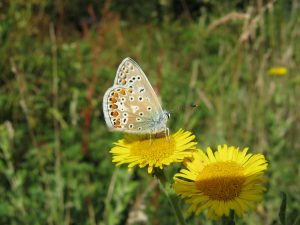Build your tan and help our butterflies
June 27, 2019
Seeing the first butterfly of the season is nature’s little way of teasing us that summer is here so we can break out the sunscreen and plan for some lazy afternoons to quietly work on our tan.
Like people, every butterfly is uniquely beautiful. They are a symbol of change, rebirth, growth, endurance and life.
They are also an indicator species whose variety and volume inform us how our environment is faring. And, over the last few decades, their decline has been one of the starkest warning signs that our natural world is in crisis.

The Pearl-Bordered Fritillary (PBF) is such a rare butterfly that just a couple of years ago it could only be found on three sites in Sussex. One of these sites is on the Cowdray Estate, where in 2016 the top count was just three and extinction seemed inevitable.
Alongside the Cowdray Estate, butterfly expert Neil Hulme, Butterfly Conservation and others, South Downs rangers and volunteers have been working in partnership on a restoration project to provide more suitable habitat for the Pearl-Bordered Fritillary.
By coppicing sweet chestnut and brashing down bracken, they’ve created more sunny woodland floor that has allowed foodplants for caterpillars, such as Common Dog Violets, to grow.
In a recent butterfly count on the site we counted an amazing 52 butterflies – a 1600% increase on the previous year. This makes the Cowdray Estate the third largest PBF colony of the seven in Sussex.
 Every stage of a butterfly’s lifecycle is reliant on having the optimum conditions.
Every stage of a butterfly’s lifecycle is reliant on having the optimum conditions.
While we can’t do much about the weather, we can continue to work with landowners and conservationists on adopting land management practices that put wildlife and biodiversity at the forefront.
The Big Butterfly Count is a nationwide survey that runs from 19 July until 11 August.
You can do your count in any sunny spot where there are butterflies. If you have a garden, that’s a good place to start, but if you want to see something special then head to some of the South Downs’ precious areas of chalk grassland.
Taking part is really easy and something you can do entirely with your phone.
Visit the Big Butterfly Count website to download the app and submit your findings.
There’s also alot you can do in your own gardens to help butterlies. Rachel Brown of DIY Garden has produced this very useful Guide to Butterflies, which includes lots of practical information on how we can turn our gardens into havens for butterflies.
